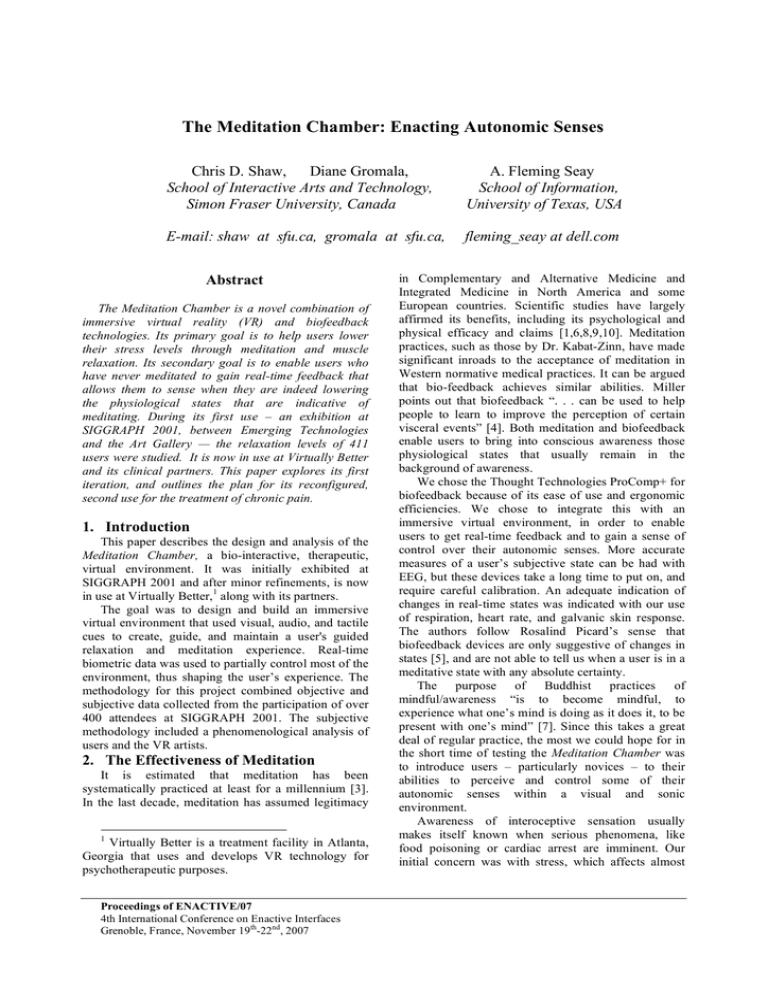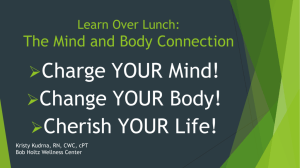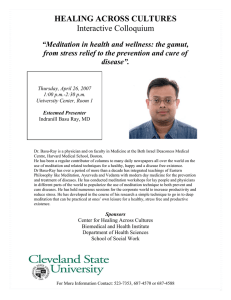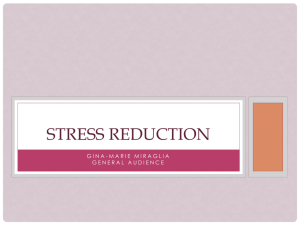The Meditation Chamber: Enacting Autonomic Senses
advertisement

The Meditation Chamber: Enacting Autonomic Senses Chris D. Shaw, Diane Gromala, School of Interactive Arts and Technology, Simon Fraser University, Canada A. Fleming Seay School of Information, University of Texas, USA E-mail: shaw at sfu.ca, gromala at sfu.ca, fleming_seay at dell.com Abstract The Meditation Chamber is a novel combination of immersive virtual reality (VR) and biofeedback technologies. Its primary goal is to help users lower their stress levels through meditation and muscle relaxation. Its secondary goal is to enable users who have never meditated to gain real-time feedback that allows them to sense when they are indeed lowering the physiological states that are indicative of meditating. During its first use – an exhibition at SIGGRAPH 2001, between Emerging Technologies and the Art Gallery — the relaxation levels of 411 users were studied. It is now in use at Virtually Better and its clinical partners. This paper explores its first iteration, and outlines the plan for its reconfigured, second use for the treatment of chronic pain. 1. Introduction This paper describes the design and analysis of the Meditation Chamber, a bio-interactive, therapeutic, virtual environment. It was initially exhibited at SIGGRAPH 2001 and after minor refinements, is now in use at Virtually Better,1 along with its partners. The goal was to design and build an immersive virtual environment that used visual, audio, and tactile cues to create, guide, and maintain a user's guided relaxation and meditation experience. Real-time biometric data was used to partially control most of the environment, thus shaping the user’s experience. The methodology for this project combined objective and subjective data collected from the participation of over 400 attendees at SIGGRAPH 2001. The subjective methodology included a phenomenological analysis of users and the VR artists. 2. The Effectiveness of Meditation It is estimated that meditation has been systematically practiced at least for a millennium [3]. In the last decade, meditation has assumed legitimacy 1 Virtually Better is a treatment facility in Atlanta, Georgia that uses and develops VR technology for psychotherapeutic purposes. Proceedings of ENACTIVE/07 4th International Conference on Enactive Interfaces Grenoble, France, November 19th-22nd, 2007 in Complementary and Alternative Medicine and Integrated Medicine in North America and some European countries. Scientific studies have largely affirmed its benefits, including its psychological and physical efficacy and claims [1,6,8,9,10]. Meditation practices, such as those by Dr. Kabat-Zinn, have made significant inroads to the acceptance of meditation in Western normative medical practices. It can be argued that bio-feedback achieves similar abilities. Miller points out that biofeedback “. . . can be used to help people to learn to improve the perception of certain visceral events” [4]. Both meditation and biofeedback enable users to bring into conscious awareness those physiological states that usually remain in the background of awareness. We chose the Thought Technologies ProComp+ for biofeedback because of its ease of use and ergonomic efficiencies. We chose to integrate this with an immersive virtual environment, in order to enable users to get real-time feedback and to gain a sense of control over their autonomic senses. More accurate measures of a user’s subjective state can be had with EEG, but these devices take a long time to put on, and require careful calibration. An adequate indication of changes in real-time states was indicated with our use of respiration, heart rate, and galvanic skin response. The authors follow Rosalind Picard’s sense that biofeedback devices are only suggestive of changes in states [5], and are not able to tell us when a user is in a meditative state with any absolute certainty. The purpose of Buddhist practices of mindful/awareness “is to become mindful, to experience what one’s mind is doing as it does it, to be present with one’s mind” [7]. Since this takes a great deal of regular practice, the most we could hope for in the short time of testing the Meditation Chamber was to introduce users – particularly novices – to their abilities to perceive and control some of their autonomic senses within a visual and sonic environment. Awareness of interoceptive sensation usually makes itself known when serious phenomena, like food poisoning or cardiac arrest are imminent. Our initial concern was with stress, which affects almost every part of the visceral systems. The seriousness of stress is often dismissed, underrated or misunderstood. Stress has extremely negative consequences: it negatively affects immunity and endocrine production and is “linked to the six leading causes of death: heart disease, cancer, lung ailments, accidents, cirrhosis of the liver, and suicide” (Canadian Mental Health Association 2007). Thus, alternative therapeutic techniques related to relaxation and the management of stress are increasingly employed to augment traditional treatment by drug-based, medical therapies. 3. The Mediation Chamber For people who are new to the practice of any form of meditation, one of the difficulties is in knowing if or when their efforts are indeed achieving anything. The resultant Meditation Chamber is comprised of an immersive virtual environment, a biofeedback device, and customized programming using the SVE Toolkit. Figure 1: The Meditation Chamber One roadblock discovered to impede the effectiveness of relaxation therapies is the consistency and quality of the user’s experience. Most formally trained doctors or assistants are not knowledgeable enough to administer alternative treatments. Also, some people have difficulty with visual imagery and are not good candidates for meditation exercises. The goal of the research project presented here was to design and build an immersive virtual environment that used visual and audio cues to create, guide, and maintain a user’s guided relaxation and meditation experience. There are several possible advantages to using a virtual environment to support meditation and guided relaxation beyond providing new meditators with realtime feedback. Patients without good mental imaging skills would still be able to benefit from the use of meditation. Clinicians with minimal training in meditation and guided imagery would be able to provide a consistent, high quality relaxation/meditation experience to their patients. Also, by providing specific meditation environments, we can guarantee that participants in future studies all receive identical training and treatment. The use of meditation and guided imagery is well established for its utility in the treatment and prevention of a number of several diseases with high cost in terms of both human suffering and financial cost. The possibility of increasing the effectiveness and repeatability of this type of therapy may receive a great deal of interest ENACTIVE/07 from the medical community. To date, we have received numerous inquiries. 4. System Design Galvanic skin response, respiration, and blood volume pulse were chosen as the biometrics of interest for this project. These biometrics were collected using the ProComp+, a commercially available device produced by Thought Technologies. The sensors described below are all standard biometric sensors produced by Thought Technologies for use with the device. Galvanic skin response (GSR), commonly used in lie-detector tests, is a measure of the change in the electrical conductivity of the skin that results from the body's reaction to emotional stimuli. It is fairly useful in measuring an individual's general level of arousal as well as tracking changes in arousal as they relate to events in the individual's environment. GSR is measured by attaching two electrodes to the user's fingertips and measuring conductivity changes in a reference charge passed through the user’s skin. The reference charge is weak enough so that no sensation is created. Respiration rate was measured using a flexible chest strap that was stretched around the user's upper chest and fitted just below the armpits. The strap was equipped with a length of rubber tubing that flexed and relaxed as the user's chest expanded and contracted during respiration. Heart Rate was measured using a blood volume pulse sensor that monitored cardiac pulse at the tip of the index finger. The audio-visual content of the environment was delivered to the user via head mounted display. The head mounted display used for this installation was the VFX-3D, produced by Interactive Imaging Systems. This bi-ocular HMD does not have a stereovisual display, but gives the user an approximately 60degree field of view, which is larger than most. The unit’s large, high quality headphones also figured in to its selection for their ability to deliver robust sound and cut down on the intrusion of external noise. A library written by Thought Technologies allowed us real-time access to the stream of data produced by the sensors. We were then able to write code that allowed us to use this data stream to manipulate aspects of the environment. This feedback loop let the user's biorhythmic state alter the environment in subtle ways just as the environment worked to relax the user. Figure 2: Image of the sunset taken from initial phase. 5. Content This initial phase served to relax users and introduce them to the experience. After being asked to breathe deeply and relax, the user was presented with a visual depiction of the sun just before sunset. A narrator's voice told users that the sun would descend in the sky as they relaxed, breathed deeply, and flushed their mind of worldly concerns (see Figure 2). The speed of the sun’s descent depended on the rate of GSR decrease. The second part of this relaxation phase operated in the same way as the first, but depicted a moonrise instead of a sunset. At each one second measurement interval, the average current GSR reading was compared to the previous second’s GSR reading, and if the GSR value had increased over the time period, the current frame of the sunset/moonrise animation would be paused. If there was a decrease in average GSR, the sunset/moonrise animation would step forward one frame. Depending on the frame-rate the user achieved, this combined sequence took 2-4 minutes to complete. Users were not told explicitly of the relationship between their GSR and the frame rate of the animation so that they would make no effort to “play” the environment and would instead concentrate on the experience of relaxation. The second phase of the experience was a guided, progressive muscle relaxation exercise. The user was coached to flex, hold, and release a set of eight different muscle groups including the legs, arms, abdominals, and shoulders (see Figure 3). Each muscle group sequence was accompanied by gender appropriate visuals depicting the described motion, usually from a first person perspective. Based on user preference, male users viewed a male body performing the exercises while female users viewed a female body. This phase was not initially interactive, but instead users listened to the narrator's instructions while mimicking the movement examples visually presented to them on the screen. The progressive muscle relaxation phase lasted roughly 6-7 minutes. The nature of flexing and relaxing the major muscle groups provided a tangible experience of the creation and, more importantly, the release of tension. The third phase was designed to teach users a basic meditation called “following your breath,” in which users are asked to focus all their awareness on the sensation of their breath coming and going from their nostrils. If other thoughts entered their awareness during this time, they were told to push them aside calmly and firmly and to remain focused only on their breath. This phase lasted approximately seven minutes and was accompanied by an abstract visual display created by putting several image filters on top of video of a swimming jellyfish. ENACTIVE/07 Figure 3: Muscle relaxation. Phase two, the muscle relaxation phase, was guided by visuals and audio narration. The image seems to pulse in time with users’ respiration. The audio during this segment sounded like abstracted, calmly moving water and was sampled from sounds taken from a waterfall. The jellyfish images faded and disintegrated as users’ biofeedback measures were reduced, and eventually faded to black. Figure 4: In Phase 3, two abstract jellyfish images. 6. The Installation The system was installed at the Emerging Technologies Exhibition at SIGGRAPH 2001, with four stations as described above. When users arrived at their reservation time, they completed a brief pre-experience inventory, and were briefed on the experience. Users were told that their biorhythms would control the environment in subtle ways, but they were not told specifically how this would occur. Users were then seated in one of the private booths and fitted with the sensors and the HMD. When ready, the application was started and the user was left alone in the booth. At the end of the experience, each user completed a postexperience inventory asking how relaxed s/he felt following the experience, and soliciting any comments. Each user's biometrics (GSR and respiration) were printed out as a line graph on the feedback sheet, which contained an explanation of how to analyze the graphical representations of the experience. Almost every user took their print-out, and approximately 85 percent of users remained to get more information. 7. Results 411 SIGGRAPH 2001 attendees experienced the installation during the five-day exhibition. We can report on the completed analysis of the subjective measures of relaxation collected in order to assess how effective the installation was in providing each individual with a relaxing experience. We have analyzed the extensive amount of biometric data collected from the SIGGRAPH attendees, concentrating mostly on the GSR data. Analyses show that two general patterns of GSR profile can account for nearly 75% of the generated data and are each generally accompanied by two distinct respiration profiles. Just over half of the participants exhibit what can be called a “novice” GSR profile. This means that their GSR level starts relatively high, descends through the first phase of the experience, increases and shows peaks in the muscle relaxation phase, and then begins to decline again in the final phase, ending up at or usually beneath the low established in the first phase. Breathing patterns in individuals exhibiting the novice profile tend to be steadier and deeper in the final phase than in the first phase. The second profile, which accounts for nearly a quarter of the GSR data, is termed the “expert profile.” Individuals exhibiting this profile show precipitous drops in GSR during the first phase, entering a very low and often flat GSR state before the muscle relaxation phase begins. This flatline state is typically maintained throughout the remaining two phases, and is accompanied by a very steady but not necessarily deep breathing pattern. Individuals exhibiting the expert GSR profile also show very consistent respiration rate and amplitude through-out the experience. We later tested a baseline condition with a user sitting quietly in a room wearing the biofeedback hardware for 20 minutes. Of our 16 baseline subjects, 8 experienced increases in GSR over the 20 minute time period. This indicates that the Meditation Chamber is effective at promoting relaxation. Users self-rate rated their level of relaxation from 1 (very anxious) to 10 (very relaxed). The average presession relaxation rating was 5.63, with a Standard Deviation (SD) of 1.75. The average post-session relaxation rating was 8.00, with a Standard Deviation of 1.69. A t-test showed that post-session relaxation ratings (M=8.00, SD=1.69) were significantly higher than pre-session ratings (M=5.63, SD=1.75), t(410) = -24.45, p=.0001. Most of the subjective comments were positive. Negative comments had to do with the heaviness of the HMD, and the noise from the other exhibits. The positive comments were that users felt relaxed, though many initially wrote that they did not expect to. At exit, when we gave users a copy of their changes in states, they became even more positive and expressed surprise that they could “learn” how to lower their measures and “feel” them. Subjective methods also included first-person, phenomenological studies, which resulted in a dissertation and several articles. These studies were integrated with objective measures have significantly impacted the reconfiguration that is underway for use in chronic pain patients. Individuals who suffer from chronic pain face many more stressors than those who suffer only more acute pain episodes. Physicians in North America understand chronic pain in a biopsychosocial model [2]. While the biological processes of chronic pain ENACTIVE/07 itself cause the body profound stress, psychological and social factors often magnify this stress. Meditation, though not a cure, has been found to lower stress levels and thus put a potential brake on the spiraling of biopsychosocial stressors. The Meditation Chamber, in helping new users meditate by providing feedback, will be tested in this realm for its potential benefits. 9. Future Work Essentially, the artistic or representational aspects are being redesigned to better accommodate cultural factors, and to integrate the subjective aspects of Buddhist meditation. Thus, users will be able to chose from “medical visualizations,” “Traditional Buddhist” imagery and sound, “Comparative Medicine Histories,” and “Abstract” representations. In addition, the sequence of meditation and guided muscle relaxation are reordered, and sensors attached to user’s knees and wrists will sync up with the muscle relaxation graphics. These extensions to the Meditation Chamber have the proven potential to enhance a user’s ability to learn how to meditate, and in doing so, reduce the damaging effects of stress. References [1] Barnes,V., Schneider, R., et al. 1997. “Stress, Stress Reduction, and Hypertension in African Americans: An Updated Review,” J. Natl Med. Assn, 89(7):464-476. [2] Gatchel, R.J., Peng, Y.B., et al., 2007. “The Biopsychosocial Approach to Chronic Pain: Scientific Advances and Future Directions”, Psychological Bulletin 133(4):581-634. [3] Gethin, R., 1998. The Foundations of Buddhism (OPUS), Oxford: Oxford University Press, New York, pg 1. [4] Miller, N.E., 1977. “Biofeedback and Visceral Learning.” In Biofeedback and Self-Control. Stoyva, J, et al., eds. New York: Aldine. [5] Picard, R., 1997. Affective Computing, Cambridge, MA: MIT Press. 122 [6] Segal Z., Williams, et al. 2001. Mindfulness-Based Cognitive Therapy for Depression: A New Approach to Preventing Relapse, Guilford Press, New York. [7] Varela, F.J., Thompson, E., et al. 1993. The Embodied Mind: Cognitive Science and Human Experience, Cambridge MA: MITPress. [8] Walton K.G., Pugh, N.D., et al. 1995. “Stress Reduction and preventing hypertension: preliminary support for a psychoneuroendocrine mechanism.” In J. Alternative Complementary Medicine, 1(3), 263-283. [9] Wenneberg, S.R., Schneider, R.H., et al. 1997. ”Anger expression correlates with platelet aggregation,” Behavioral Medicine, vol. 22, no. 4, pp.174-177. [10] Zamarra, J.W., Schneider, R.H., et al. 1996. “Usefulness of the transcendental mediation program in the treatment of patients with coronary artery disease.” Am.J. Cardiology, 77(10), 867-870.



